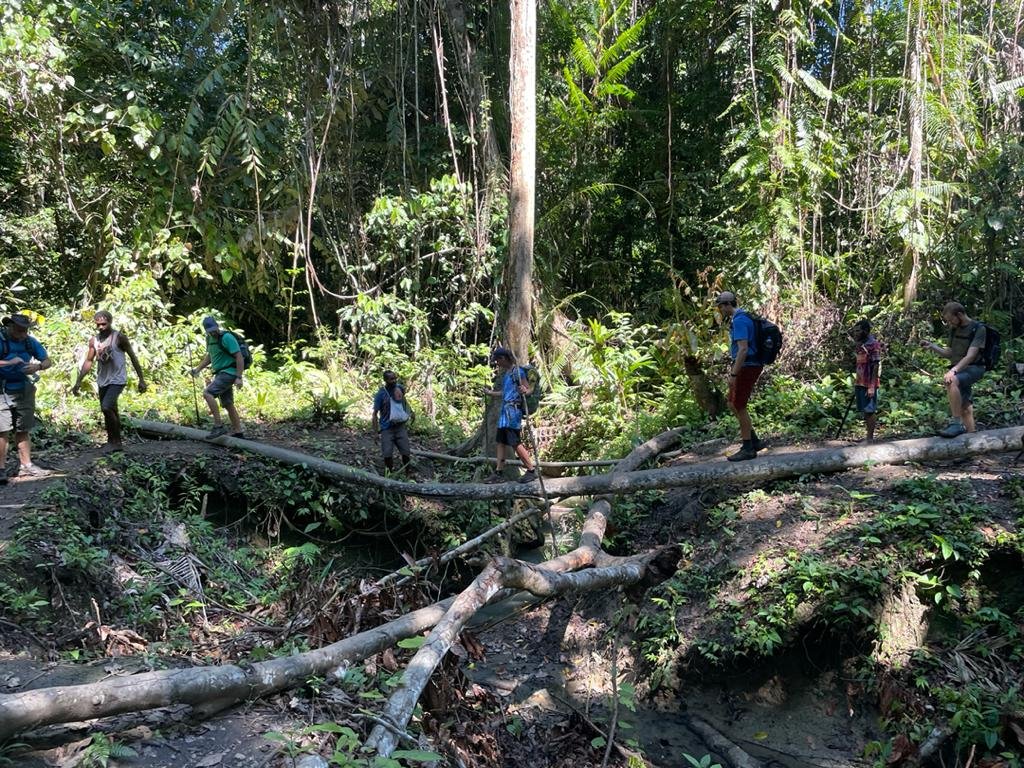Weaving It Together
We are nearly 6 months into our new life here in Papua New Guinea.
Recently I got a chance to weave some “blain” (blind) with a man here in the highlands. They have a similar process in Madang, but with a different plant and a different method. Blain is what they make their walls with, and He was about halfway through weaving it for a house his family is building on their land.
As missionaries, we’ve been taught to learn language from the culture. This means that we learn the language in the context it is spoken. If we are learning about nouns for house building, we build a house with the people. Words for food, we garden.
A lot of the initial nouns, verbs, and “how-to” is pretty easy (especially with the trade language Tok Pisin) But what about why they are making the blain? Who is making it and for whom? When is the best time of day or year to make the blain? Where did they source the material? What if they don’t have any materials of their own? Would they ask their families or friends? These questions can lead you to understand the social, economic, and sometimes even spiritual worlds they live in every day.
Or maybe it’s just a wall. And that’s okay too. We can’t find out if we don’t ask.
Kelsey and I are about halfway through our language study. A week ago we closed our first chapter of culture and language study when we left Madang. Now we are living on a mission base in the mountains close to the town of Goroka. We are still working away, weaving together an understanding of the greater language and culture of Papua New Guinea. It’s all part of “becoming” PNG so that we can communicate the gospel and disciple with a clear understanding of how they see the world.
HIGHLIGHTS
Madang
For the past 5 months, we have been living on a base near the coastal town of Madang. Our time has been focused on orientating us to Papua New Guinea and refreshing us to the process of church planting in PNG. Here are some of the highlights:
Pictured: Madang men dressed up for a singsing in traditional Madang dress.
NCLA (national culture & language acquisition)
We are loving our time with our National friends as they teach us their language. Learning Tok Pisin is like a dry run for us as church planters before we go into a tribe to learn their much harder “Tok Ples” (talk place or tribal language.) We now get to practice a lot of the language learning skills we got in our missionary training.
Pictured: Kelsey during her Tok Pisin evaluation with her previous language helper and one of our CLA consultants.
Kaje tribe
In the middle of August Nathan had the privilege to hike in and visit a missionary team working among the Kaje people. The missionaries in Kaje had presented the Gospel just 2 years ago and are now working to disciple the young church. It was so encouraging to see clearly a church plant in PNG first-hand. All glory to God!
Pictured: the group on one of the many log crossings during the hike into Kaje.
Language helpers
Now that we are settled into the highlands we are beginning new relationships with the community and finding new language helpers. Kelsey already has a couple of solid language helpers here and I’ve been able to get out a lot in the village and make a lot of new relationships. The village is much closer than the one in Madang which is really awesome! The kids are able to get out more with us and we can more easily get language time in.
Pictured: our friend Michael, Ralf, and Abale took us on a walkabout around the area near Sobega soon after arriving. It is beautiful up here.
Kids in the village
At the same time we are learning a new way of life and a new language, our kids are too. Both Simeon and Sienna grew so much through our months in Madang, they learned along side us, helped us break the ice, and made friendships of their own! We are seeing them do the same here. We are grateful for them and all the joy they bring to us and others!
Transitioning to Sobega
We are praising God for how our family has transitioned to living in the highlands! We arrived here in Sobega on October 15th. We are beyond thankful for the community here that has welcomed us and introduced us to the surrounding community.
Right now, it is time to plant gardens before the rainy season comes. Kelsey and I have been getting out and breaking ground with our new friends here for their new gardens and it is serious work!
Pictured: Our friend, Malai, in Madang digging holes for his yam garden. He makes it look easy.
Life is very different up in the mountains than by the ocean, from the rugged terrain to a different dialect of Tok Pisin and many cultural and temperament differences. It has been fun learning just a few of the different cultures here in PNG among the many represented in this country!
Timeline update
In the next couple of months, we will be living on the highlands/central area mission base of Sobega. Our main role will be completing our Tok Pisin language and national culture study. We will also be helping out in support ministries on base that help sustain church planters in the bush while we look for co-workers and a tribe to move into. At some point, we will be going into Bush Orientation where we will learn from experienced missionaries in a bush location with a thriving church. More on that to come!







